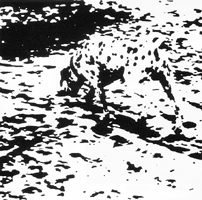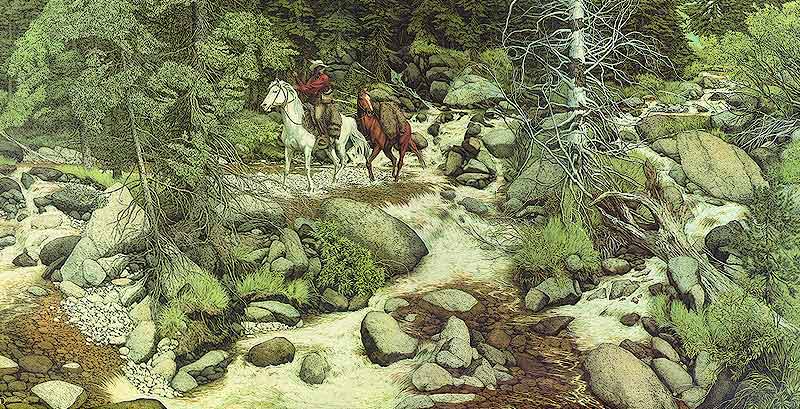 .
If so your early visual areas are grouping some spots into this Dalmatian, by R
C James, and segregating them from the background. What about the letter E?
.
If so your early visual areas are grouping some spots into this Dalmatian, by R
C James, and segregating them from the background. What about the letter E? 
LinKs to interesting web sites
Higher Visual Areas
Brain imaging pioneer Nancy Kanwisher, who uses fMRI scans to see activity in brain regions (often her own), shares what she and her colleagues have learned. A highly recomended TED talk called "A neural portrait of the human mind."
Can you see the dog?
 .
If so your early visual areas are grouping some spots into this Dalmatian, by R
C James, and segregating them from the background. What about the letter E?
.
If so your early visual areas are grouping some spots into this Dalmatian, by R
C James, and segregating them from the background. What about the letter E? 
![]() Artists,
such as Bev Doolittle, use perceptual binding to create art.
Artists,
such as Bev Doolittle, use perceptual binding to create art.
Can you see 5
pintos? 
How many faces? 
![]() What hallucination reveals about our minds | Oliver Sack
What hallucination reveals about our minds | Oliver Sack
![]() Some other cues the the early visual areas use to segregate the feature that belong to an object from those that belong to the background. From Stephen Palmer.
Some other cues the the early visual areas use to segregate the feature that belong to an object from those that belong to the background. From Stephen Palmer.
![]() A great interview by the CBC with a photographerwho has face blindness on You Tube. Be patient or skip over the short intro. And on the lighter side.
A great interview by the CBC with a photographerwho has face blindness on You Tube. Be patient or skip over the short intro. And on the lighter side.
![]() What happens when you stimulate the face area?
What happens when you stimulate the face area?
![]() Changing Faces: Stimulating the Brain Morphs People’s Faces Before Patient’s Eyes
Changing Faces: Stimulating the Brain Morphs People’s Faces Before Patient’s Eyes
![]() A patient with visual agnosia.
A patient with visual agnosia.
![]() Dave Purves
demonstrates how the interpretation of what the eye sees by higher visual areas
can result in some remarkable illusions.
Dave Purves
demonstrates how the interpretation of what the eye sees by higher visual areas
can result in some remarkable illusions.
![]() Face Blindness: Oliver Sacks - The Mind's Eye
Face Blindness: Oliver Sacks - The Mind's Eye
![]() How do portrait painter Chuck Close and author Oliver Sacks cope with the difficulties of face blindness?
How do portrait painter Chuck Close and author Oliver Sacks cope with the difficulties of face blindness?
![]() Read
about the man who can't recognize faces, even his own!
Read
about the man who can't recognize faces, even his own!
![]() Do you think you might have face blindness? Participate in a test from Harvard and the University College London.
Do you think you might have face blindness? Participate in a test from Harvard and the University College London.
![]() Bill Choisser describes
what it is like to be face blind.
Bill Choisser describes
what it is like to be face blind.
|
Copyright © |
Last updated
August 31, 2016
|